It's Time to Sip the MarTech Kool Aid
by Jeff Winsper
Scott Brinker has done it again! I don’t envy the task of trying to collect nearly 4,000 unique marketing technology brands and organize them into a neat and orderly fashion, especially in a way that actually makes sense. Of course, piecing together this collage makes even the toughest jigsaw puzzle seem lame. Well done, Scott!
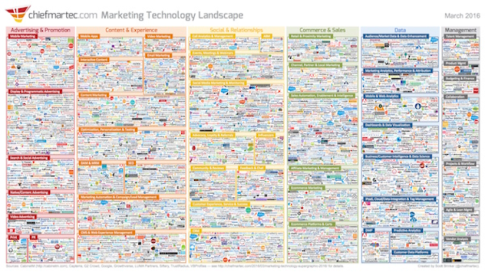
Scott Brinker’s annual effort to categorize and organize the ever-increasing marketing technology landscape has developed into a cult movement of people eagerly waiting for the big reveal, and a rather large one at that. When all of this started back in 2011, I’m not sure Scott was signing up for this to be an annual event. However, I do know Scott is blazing paths in the MarTech space, which is on fire right now. (Get it?)
Recently, Black Ink ROI conducted their C-level 2016 Marketing Study that resulted in some cool findings that piggyback on Scott’s learning’s, too. The brands surveyed were mostly F1000 and included a nice cross section of various industries. Scott had the opportunity to review the study prior to its public launch, and offered some kind words:
“Today’s sea change for all levels of marketers is unprecedented. This C-level 2016 Marketing Study captures the essence of how marketers are adapting or leading the charge. There is enough evidence from these leading brands that they desire to deliver a superior brand experience to remain customer-centric by leveraging Marketing technology (MarTech) at the core.” - Scott Brinker, Editor at Chiefmartec.com, Program Chair at the MarTech Conference, and Author of Hacking Marketing
One of the notable changes from Scott’s 2015 supergraphic to this year is his adjusted notion of single platform to multi-platform. Even the Stackie Awards demonstrate how marketers have a different lens in which they buy and use MarTech. Here is what I believe are the drivers for unique use cases from company to company:
- The category is nascent yet with an explosion of options. This supports Scott’s ever evolving changing of the categories within his landscape.
- No maturity for buying process combined with maturity of buyers.
- Far too many nuances between business sectors (i.e. Consumer Durable Goods is very different than Consumer Packaged Goods)
- Budget cycles for technology takes time (unless it is a swipe and go <$100 SaaS offering)
- Range of users, consumers and operators of systems, and…
- Availability of current support/infrastructure available to manage the security, data management, integration across Marketing, Sales and IT Operations.
This much is true; the cults are all sipping the MarTech Kool Aid and marching towards the light. Some go to one mountaintop to find Nirvana, while others trek up another; both think they’ve found enlightenment.
Below outlines some research from the Black Ink ROI’s C-Level 2016 Marketing Study to support this claim:
1. MarTech/Infrastructure is a top 5 priority in 2016.
Out of the top 10 marketing priorities in 2016, Reporting/Insight is #3, MarTech is #4, and Omni-channel promotions is #5.
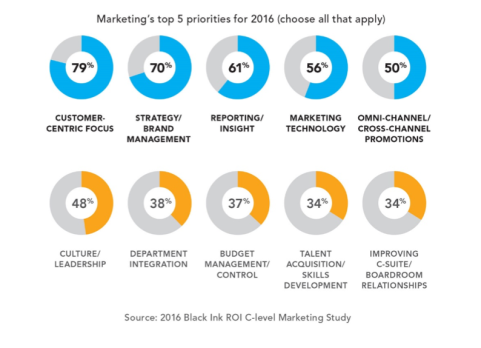
Additionally, MarTech is rated #1 by marketers as ‘least able to execute’ (below average + unsatisfactory). One could also argue that a strong MarTech stack also supports a more contemporary way to improve Reporting/Insight as well as more modern Omni-channel deployment techniques.
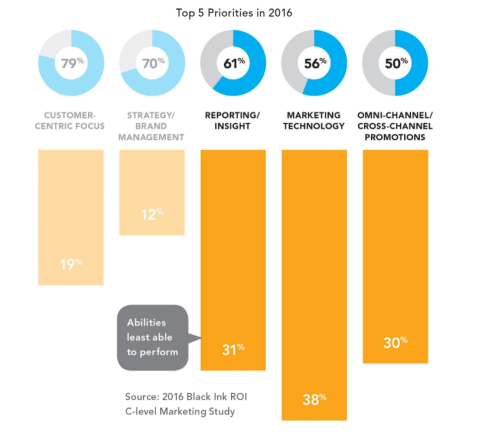
2. Marketers are drowning in data? Quite the opposite, there are gaps everywhere.
Marketers are challenged by what to do with what they have for data access, let alone understand how to get more of it from both internal and external systems. Pre-sale consumer behavior is the #1. ranked-data source marketers have the least or no access to it. This surprises me, considering about 80% of all the MarTech brands land in the customer interaction space. In my humble opinion, marketers are still guessing and flying blind across the board, which is pretty scary. As an aside, consumer/customer demo/psycho and Omni-channel are tied for #4. I find this also particularly interesting since being "customer-centric" was the #2 description that best fits their company's attribute and was a #1 top priority in 2016.
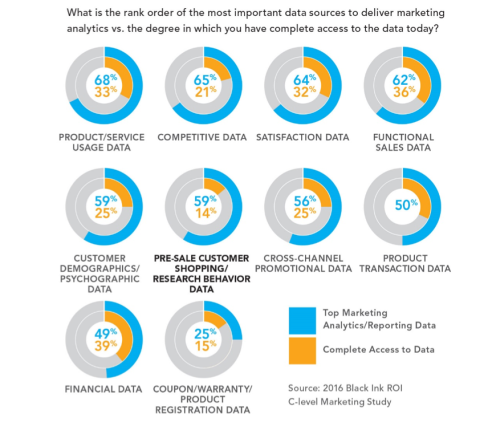
3. Access to advanced analytics to make smarter decisions is the #1 barrier. This supports the data management gap.
Across all industries, needing better analytics was, by and far, the self-proclaimed barrier. After all, data drives, but gut decides. Without having the ability to make the next best action, marketers are invariably spending their way to the answer. And we all know the Office of Finance is not a big fan of that model.

I think the challenge in trying to interpret this under the context of the major categories by Scott Brinker, is there is truth that most, if not all, offerings have some sort of analytics capability embedded. So it depends on the type of decision one wants to make. If it is analyzing how one’s mobile efforts are progressing, then look at the mobile analytics details of that app. If it’s about email, then look at your marketing automation app…and so on. However, if you look at the data category in the image below, there is a designated sub-section called analytics. This is where I believe the rubber meets the road. Having 3, 5, or even 15 different apps in your stack can cause angst for one singular view of the truth. I call this Enterprise Marketing Analytics. By taking all of the data being generated internally and externally, it’s far more fruitful to understand how cause and effect at each micro-level adds up to the total view of the pie. Whether you want to measure marketing ROI, customer lifetime value, new revenue growth opportunities to realize revenue, it is virtually impossible with just one slice.
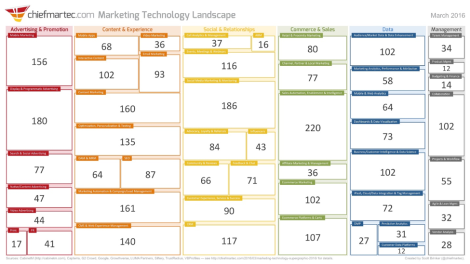
With the marketing technology industry here to stay, it’s time to take a big sip of the Kool Aide. Marketers can now rely on smart guidance to avoid flapping about in the deep end of the pool. A smart, sound strategy to connect the MarTech tools that align with business growth goals helps keep people in their swim lanes, and ultimately win the race.
